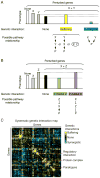CRISPRi and CRISPRa Screens in Mammalian Cells for Precision Biology and Medicine
- PMID: 29035510
- PMCID: PMC5886776
- DOI: 10.1021/acschembio.7b00657
CRISPRi and CRISPRa Screens in Mammalian Cells for Precision Biology and Medicine
Abstract
Next-generation DNA sequencing technologies have led to a massive accumulation of genomic and transcriptomic data from patients and healthy individuals. The major challenge ahead is to understand the functional significance of the elements of the human genome and transcriptome, and implications for diagnosis and treatment. Genetic screens in mammalian cells are a powerful approach to systematically elucidating gene function in health and disease states. In particular, recently developed CRISPR/Cas9-based screening approaches have enormous potential to uncover mechanisms and therapeutic strategies for human diseases. The focus of this review is the use of CRISPR interference (CRISPRi) and CRISPR activation (CRISPRa) for genetic screens in mammalian cells. We introduce the underlying technology and present different types of CRISPRi/a screens, including those based on cell survival/proliferation, sensitivity to drugs or toxins, fluorescent reporters, and single-cell transcriptomes. Combinatorial screens, in which large numbers of gene pairs are targeted to construct genetic interaction maps, reveal pathway relationships and protein complexes. We compare and contrast CRISPRi and CRISPRa with alternative technologies, including RNA interference (RNAi) and CRISPR nuclease-based screens. Finally, we highlight challenges and opportunities ahead.
Figures



References
-
- Barrangou R, Fremaux C, Deveau H, Richards M, Boyaval P, Moineau S, Romero DA, Horvath P. CRISPR provides acquired resistance against viruses in prokaryotes. Science. 2007;315:1709–1712. - PubMed
-
- Cho SW, Kim S, Kim JM, Kim JS. Targeted genome engineering in human cells with the Cas9 RNA-guided endonuclease. Nat Biotechnol. 2013;31:230–232. - PubMed
Publication types
MeSH terms
Substances
Grants and funding
LinkOut - more resources
Full Text Sources
Other Literature Sources
Medical

